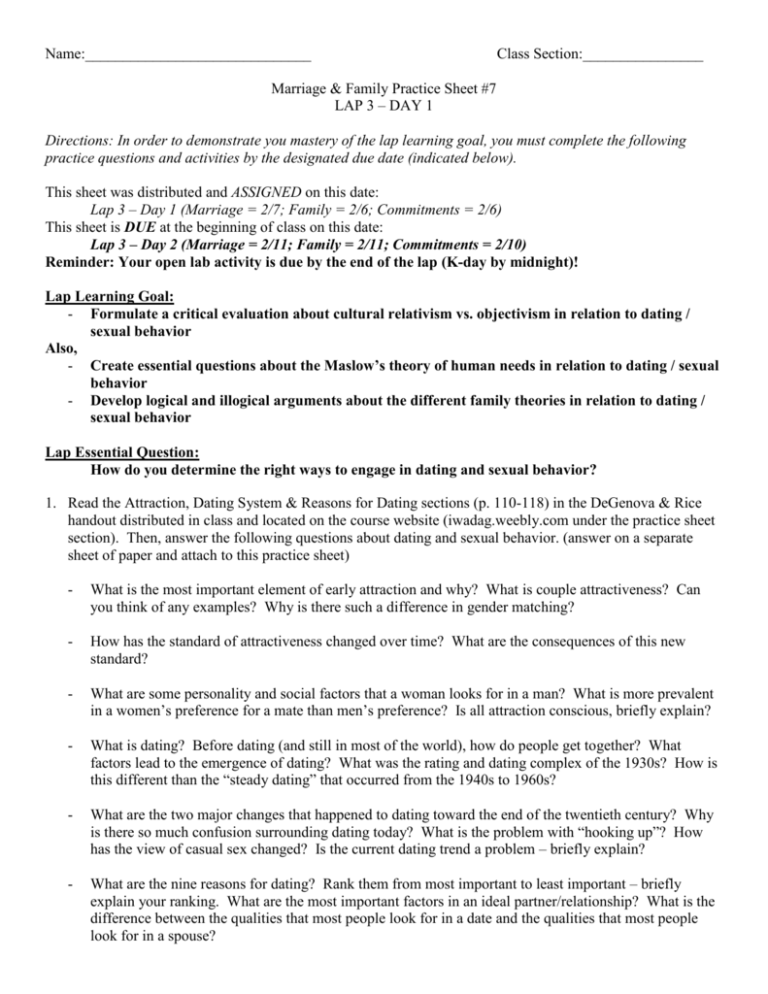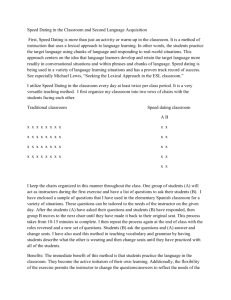
Name:______________________________
Class Section:________________
Marriage & Family Practice Sheet #7
LAP 3 – DAY 1
Directions: In order to demonstrate you mastery of the lap learning goal, you must complete the following
practice questions and activities by the designated due date (indicated below).
This sheet was distributed and ASSIGNED on this date:
Lap 3 – Day 1 (Marriage = 2/7; Family = 2/6; Commitments = 2/6)
This sheet is DUE at the beginning of class on this date:
Lap 3 – Day 2 (Marriage = 2/11; Family = 2/11; Commitments = 2/10)
Reminder: Your open lab activity is due by the end of the lap (K-day by midnight)!
Lap Learning Goal:
- Formulate a critical evaluation about cultural relativism vs. objectivism in relation to dating /
sexual behavior
Also,
- Create essential questions about the Maslow’s theory of human needs in relation to dating / sexual
behavior
- Develop logical and illogical arguments about the different family theories in relation to dating /
sexual behavior
Lap Essential Question:
How do you determine the right ways to engage in dating and sexual behavior?
1. Read the Attraction, Dating System & Reasons for Dating sections (p. 110-118) in the DeGenova & Rice
handout distributed in class and located on the course website (iwadag.weebly.com under the practice sheet
section). Then, answer the following questions about dating and sexual behavior. (answer on a separate
sheet of paper and attach to this practice sheet)
-
What is the most important element of early attraction and why? What is couple attractiveness? Can
you think of any examples? Why is there such a difference in gender matching?
-
How has the standard of attractiveness changed over time? What are the consequences of this new
standard?
-
What are some personality and social factors that a woman looks for in a man? What is more prevalent
in a women’s preference for a mate than men’s preference? Is all attraction conscious, briefly explain?
-
What is dating? Before dating (and still in most of the world), how do people get together? What
factors lead to the emergence of dating? What was the rating and dating complex of the 1930s? How is
this different than the “steady dating” that occurred from the 1940s to 1960s?
-
What are the two major changes that happened to dating toward the end of the twentieth century? Why
is there so much confusion surrounding dating today? What is the problem with “hooking up”? How
has the view of casual sex changed? Is the current dating trend a problem – briefly explain?
-
What are the nine reasons for dating? Rank them from most important to least important – briefly
explain your ranking. What are the most important factors in an ideal partner/relationship? What is the
difference between the qualities that most people look for in a date and the qualities that most people
look for in a spouse?
2. Read the Ethical Relativism section (p. 411-415) in the “Ethical Relativism vs. Objectivism” handout
distributed in class and located on the course website (iwadag.weebly.com under the practice sheet section).
Leading questions #1 and #2 represent the viewpoint of ethical relativism. Write your answers and thoughts
to these questions below. Also, in your own words, briefly explain the difference between subjectivism and
conventionalism within the ethical relativism realm.
3. Now that you have read about ethical relativism, apply this concept to issues surrounding dating and sexual
behaviors in our society. For example, different cultures around the world have different practices
surrounding dating and acceptable sexual behavior. Find at least one dating practice or sexual behavior that
is practiced differently within various cultures. Then, briefly explain how a subjective ethical relativist and
a conventional ethical relativist would view the cultural / ethical differences.









